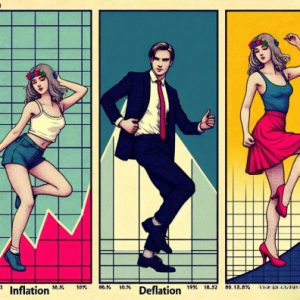
Which Situation Would a Savings Bond Be the Best Investment? Amidst Panic?
Apr 17, 2024
I. Introduction
So the question is, “Which Situation Would a Savings Bond Be the Best Investment?” To begin with, understanding the optimal times for investing in savings bonds is crucial for maximizing financial returns and minimizing risks. Savings bonds, often considered a conservative investment choice, provide a unique avenue for earning interest, particularly in volatile financial climates. This essay explores the interplay between mass psychology and market cycles and how they influence investment decisions in savings bonds. By examining various factors, including economic conditions, personal financial situations, and bond characteristics, alongside insights from top traders in history, this essay aims to delineate scenarios where savings bonds might be the most advantageous investment for earning interest.
Mass Psychology and Market Cycles
Euphoria and Market Peaks
During periods of market euphoria, when asset prices are excessively high due to overly positive investor sentiment, the risk of a market correction or crash increases. These periods often precede significant downturns (e.g., the dot-com bubble burst in 2000). In such times, prudent investors often seek refuge in safer assets like savings bonds. The shift to bonds is motivated by the desire to preserve capital amidst impending market corrections, thus leveraging the stability offered by government-backed securities.
Fear and Market Bottoms
Conversely, periods of market lows are often characterized by widespread investor fear and panic. These phases present unique opportunities for investors to purchase riskier assets at lower prices, anticipating potential high returns as markets recover. However, the transition from bonds back to stocks or other high-risk assets should be timed with careful consideration of market signals and a rebound in investor confidence. This strategic shift can capitalize on the cyclical nature of markets to maximize returns.
Historical Examples
Historical market cycles provide clear examples of how mass psychology influences investment decisions. During the Great Depression, the sharp decline in stock market values saw a surge in bond investments as investors sought safety. Similarly, during the financial crisis of 2008, the trend of moving into bonds was evident as the stock markets plummeted, reflecting heightened economic uncertainties and a flight to quality.
Other Factors to Consider When Investing in Bonds
Economic Conditions
Interest rates and inflation significantly impact the attractiveness of bonds. Typically, a rise in interest rates makes newly issued bonds more lucrative (offering higher yields) than older ones, and vice versa. Additionally, during periods of high inflation, the real return on bonds might diminish unless they are inflation-indexed, which makes understanding these economic indicators crucial before investing in bonds.
Personal Financial Situation
An individual’s risk tolerance and investment timeline are pivotal in deciding whether to invest in savings bonds. For instance, individuals nearing retirement might favour the low-risk nature of savings bonds, ensuring capital preservation. Younger investors with a longer time horizon might prefer riskier assets with potentially higher returns, adjusting their bond investments according to life stages and financial goals.
Bond Characteristics
Credit quality and maturity date are critical in bond investment decisions. High-credit quality bonds, such as government securities like savings bonds, offer lower risk and returns than corporate bonds with lower credit ratings. For instance, during the 2008 financial crisis, investors flocked to the safety of U.S. Treasury bonds, driving their yields to historic lows. This flight to quality demonstrated the importance of credit quality in times of economic uncertainty. Backed by the full faith and credit of the U.S. government, savings bonds are often the best investment for earning interest when market volatility is high, and capital preservation is paramount.
Moreover, the maturity date affects liquidity and interest rate risk. Longer-term bonds generally offer higher yields but are more sensitive to interest rate changes. When interest rates rise, the value of existing bonds with lower rates decreases, as investors prefer newer bonds with higher yields. This inverse relationship between interest rates and bond prices is a crucial consideration for bond investors.
For example, if an investor purchased a 30-year Treasury bond with a 3% yield and interest rates subsequently rose to 4%, the value of the bond would decrease as newer bonds would offer a more attractive return. Conversely, if interest rates fell to 2%, the value of the original bond would increase, as its 3% yield would be more desirable than the lower rates available in the market. Understanding the interplay between maturity dates and interest rate risk is essential for making informed bond investment decisions.
Insights from Top Traders Throughout History
Jesse Livermore
Jesse Livermore emphasized the importance of patience and discipline in investing. His strategies advocate for waiting for the right moment to enter and exit the market, principles that can be applied to investing in bonds during market highs and lows.
Benjamin Graham
Benjamin Graham’s principles of value investing and the margin of safety are particularly relevant to bond investment. Graham advocated investing in securities that offer significant protection against loss, such as high-quality bonds, incredibly when undervalued during market downturns.
Ray Dalio
Ray Dalio’s risk management and diversification strategies stress the importance of having a well-balanced portfolio, including bonds. Dalio’s approach suggests that bonds can counterbalance to more volatile investments, highlighting their role in comprehensive investment strategies.
Conclusion
The decision to invest in savings bonds and the timing of such investments is influenced by a confluence of factors, including mass psychology during market cycles, economic conditions, personal financial situations, and specific bond characteristics. Historical and contemporary insights from top traders underscore the importance of discipline, value assessment, and strategic diversification. In scenarios where markets are peaking or during high economic uncertainty, savings bonds offer a sanctuary for capital preservation and steady interest earnings. Therefore, understanding these multifaceted factors can guide investors towards making informed decisions about when savings bonds might represent the best investment to earn interest.
Nourish Your Intellect: Dive In!

Discover How the Extra Return Generated Through Stock Market Timing Strategies Should Be

Stock Market Fear Meter: All Bark, No Bite

Stock Market Forecast for Next Week: Ride the Thrilling Trend!

Rags to Riches Stories: The Power of Perseverance and Discipline

Dow Jones Average Chart: Trading for Success

Financial Disaster Recovery Plan: Buying the Crash, Selling the Joy

Inflation vs Deflation vs Disinflation: Navigating and Winning

Unmasking Deceit: Examples of Yellow Journalism

Crude Oil Crash: Unveiling Crowd Stupidity and Opportunity

Mass Psychology Overview: Unveiling its Enigmatic Dynamics

What is Mass Psychology: Mastering the Investment Game

Strategic vs Tactical Asset Allocation: The Dominating Difference

When Inflation is, the Fed Aims to Slow the Economy

Latest Stock Market News: Making Money With Mass Psychology

People Who Went From Rags to Riches and How They Did It
FAQ: Which Situation Would a Savings Bond Be the Best Investment?
1. How do periods of market euphoria and fear impact investment decisions?
During market euphoria, when asset prices are excessively high due to overly positive investor sentiment, the risk of a market correction or crash increases. Prudent investors often seek safer assets like savings bonds to preserve capital. Conversely, periods of market lows, characterized by widespread fear and panic, present opportunities to purchase riskier assets at lower prices, anticipating potential high returns as markets recover
2. What historical examples demonstrate the influence of mass psychology on market cycles?
The Great Depression saw a surge in bond investments as stock markets declined sharply and investors sought safety. Similarly, during the 2008 financial crisis, the trend of moving into bonds was evident as stock markets plummeted, reflecting heightened economic uncertainties and a flight to quality.
3. Apart from market sentiment, what other factors should investors consider when investing in bonds?
Investors should consider:
Economic conditions: Interest rates and inflation significantly impact bond attractiveness. Rising interest rates make newly issued bonds more lucrative, while high inflation can diminish actual returns.
Personal financial situation: Risk tolerance and investment timeline are pivotal. Older investors nearing retirement might favour low-risk savings bonds, while younger investors with longer horizons might prefer riskier assets with potentially higher returns.
Bond characteristics: Credit quality and maturity date affect risk and returns. High-credit quality bonds offer lower risk but lower returns than lower-rated corporate bonds. Longer-term bonds generally offer higher yields but are more sensitive to interest rate changes.


